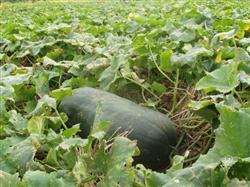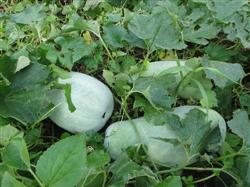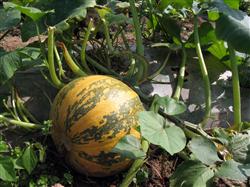How to grow wax gourd in open field in spring?

How to grow wax gourd in open field in spring? How to manage after planting? Planting wax gourd in open field in spring can refer to the following methods: first, varieties should be selected with good plant growth potential, poor branching ability, strong sunburn resistance, large fruit type, middle and late ripening varieties with wax powder, such as Beijing wax gourd and powdered wax gourd. Generally do not choose green skin wax gourd, because of its poor ability to resist sunburn, not suitable for climbing cultivation. Second, select the land for the border and select the land with high topography, good drainage and loose soil. Cultivation beds are generally composed of planting beds and creeping beds, which are arranged at intervals. There are usually two ways to make a bed: 1. The width of the one-way border is 83 cm, the north and south are juxtaposed into a group, the north is cultivated, the south is crawling, and the north is higher, gradually tilting to the south to ward off the north wind and keep out the cold. A row of wax gourd was planted on the base fertilizer, and the wax gourd extended to the south. two。 According to the east-west extension direction, the two-way border is made into a cultivation bed 1.3 to 1.5 meters wide, and a parallel creeping border is made on each side of the north and south, with a width of 83 centimeters. Two rows of wax gourd were planted on the base fertilizer, and the wax gourd extended southward and northward. Third, the planting time is after the local late frost in spring, the planting depth should be buried melon seedling soil, and the method can be divided into two methods: common planting method and water stable seedling method. 1. In the common planting method, the planting hole is dug according to the length and width of 60cm and 66cm, and the seedlings are gently put into the hole, cover the soil and bury the soil, and then irrigate the planting water. two。 In the method of stabilizing seedlings with water, a shallow ditch with a depth of 13 cm to 16 cm and a width of 20 cm was first opened and watered into the ditch. When the water was half seeped, the seedlings were placed in the ditch, and the ditch was sealed with soil after the water was completely seeped. 4. fertilizer and water management of winter gourd should focus on the cultivation border, and watering and fertilization can be combined; climbing vine border generally does not carry out special watering and topdressing, but can be carried out according to the requirements of intercropping and interplanting crops. In the early stage of melon vine growth, open a ditch 20 cm deep in front of the seedlings, spread farm manure in the ditch, 10 kg per ditch, and then irrigate, and then apply chemical fertilizer after water infiltration, 1 kg per ditch; after the stems and vines are covered with cultivation beds, no longer open ditches to water and fertilize, but can be watered according to moisture, chemical fertilizer and dilute manure are applied with water, the dry season is generally 5-10 days watering, no watering in the rainy season, and should pay attention to drainage and waterlogging prevention. 5. Other management in the field. After weeding and watering with planting water, the middle ploughing was carried out on the principle of not loosening the roots of the seedlings, and the semicircular mound was properly cultivated at the base of the seedlings. When the soil moisture is good, it can be ploughed for 2 or 3 times and then watered. two。 Wire rod, pressure vine when the stem vine extends to 60 to 70 centimeters long, to wire rod, pressure vine. The method is: open a semicircular shallow trench along the north side of the root of each seedling, with a depth of 6-7 cm, pan the vine to the north into the ditch, and bury it with soil and compaction. When pressing the vine, pay attention to make the 2-3 leaflets at the end of the stem exposed to the ground, do not bury the growing point into the soil. When the stem vine extends forward by 60 to 70 centimeters, use the same method to open a shallow trench on the south side to make the second wire rod and press the vine. The vine is pressed once every 4 ~ 5 leaf nodes, and it can be pressed three or four times in the whole growing period. Pay attention to the removal of excess side vines, tendrils and male flowers. For plants with strong growth, the vines can be deeper and the stems can be twisted and split into the soil; the plants with weak growth can be shallower, the nodes should be farther away, and they should not be close to the fruit (preferably one or two nodes from the fruit), and the nodes of female flowers should not be pressed into the soil. For the side branches sent out, the principle of keeping if there is space and pinching off if there is no space is adopted in production. 3. It is better to select and fix melons with the second to fifth female flowers, and to choose young melons with good variety characteristics, normal shape, rapid development, large fruit shape and hairy. When the young melon sits down and bends its neck, the melon can be determined when the single melon weighs 0.3 to 0.5 kilograms, leaving one or two of the fastest growing, largest and strongest fruits, and all the rest of the fruits will be removed. 4. When turning melons and cushions, you should be careful when turning melons. Each time you gently turn about 1x4. When turning melons, you should cooperate with melon stalks and vines. Do not break stems and leaves. Generally, turn once every 5-8 days, and the time is suitable for sunny days. In order to prevent melons from rotting, each melon is covered with a straw mat, which is made of wheat straw, straw and so on. 6. prevention and control of common diseases and insect pests. Common diseases include quenching disease, blight, Fusarium wilt, anthrax, downy mildew, virus disease, powdery mildew and so on. Prevention and treatment of ① cataplexy. Select the plot that has not planted melon crops in the previous crop as the seedling bed, turn the bed soil as soon as possible, the organic fertilizer should be rotten, the bed surface should be flat and without large soil particles, cover early before sowing, and raise the bed temperature to more than 20 ℃. Copper-ammonium mixture should be used to prevent and cure the disease of seedlings (that is, 1 part of copper sulfate and 2 parts of ammonium bicarbonate, grind into powder and mix, seal in an airtight container for 24 hours). Take out 50 grams of copper-ammonium mixture and rinse 12.5 liters of water each time and spray the bed surface. Prevention and control of ② blight and other diseases. To control blight, 72% DuPont Krou or 69% Anke manganese zinc wettable powder 900 times, Fusarium wilt can be sprayed with 50% mixed sulfur suspension 500 times, or 70% mancozeb wettable powder 500 times, anthracnose can be sprayed with 50% carbendazim wettable powder 800 times, or 2% antimycin 200 times. Downy mildew can be sprayed with 58% metalaxyl manganese zinc 500 times, or 40% ethyl phosphorus aluminum wettable powder 1500 times, or 25% pyrethromycin 1500 times, once every 6 to 7 days, continuous control for 2 times; virus disease can be prevented and treated with virus A, phytopathrin, 83 resistance enhancers, and powdery mildew can be sprayed with 15% chlorhexidine wettable powder, or 20% trimethoprim EC 2000000 times, once every 7 days for 2 times in a row. two。 The common insect pests are melon aphid and whitefly, which should be controlled by spraying low toxic pesticides as soon as possible. Harvest when the fruit is fully developed, it can be harvested at any time according to the market situation when it grows to a certain size. The yield is lower when harvested prematurely, but the storage must meet the physiological maturity standard. Click to get more wax gourd planting techniques click to get more vegetable planting techniques
- Prev

How to manage planting wax gourd in paddy field?
How to manage planting wax gourd in paddy field? What are the ways to increase production? Planting wax gourd in paddy field can increase yield in the following three ways: fertilizer and water management. It is not easy to water the stem of wax gourd at the growth stage, so we should take the management measures of "promoting" and "controlling". After watering, we should plough and preserve soil moisture and prolong the interval of watering.
- Next

How should seed pumpkins be managed?
How should seed pumpkins be managed? Please give guidance to seed pumpkin management can refer to the following methods: early seedlings early set seedlings between pumpkin seedlings early rather than late, early seedlings, fixed seedlings, conducive to ventilation and light, promote early growth and rapid development of seedlings, generally start seedlings with hands, it is best to fix seedlings during 2-leaf period and 3-leaf stage.
Related
- Where is it suitable to grow horseradish in China? it is expected to see the middle altitude horseradish in Alishan.
- How to prevent tomato virus disease reasonably? (Control methods included)
- Many people like to plant towel gourd on the balcony. What are the main points of this method and management?
- What crops can chili peppers be mixed with?
- Fertilization techniques and matters needing attention in Tomato
- What are the grafting techniques for peach seedlings in spring?
- Harm and control methods of root swelling disease of Chinese cabbage
- What are the pests of sweet potatoes? How to prevent and cure it?
- Symptoms, causes and Control methods of navel Rot in Tomato
- The cause of "Cucumber rotten bibcock" in Farmers' planting Cucumber and its Control Plan

